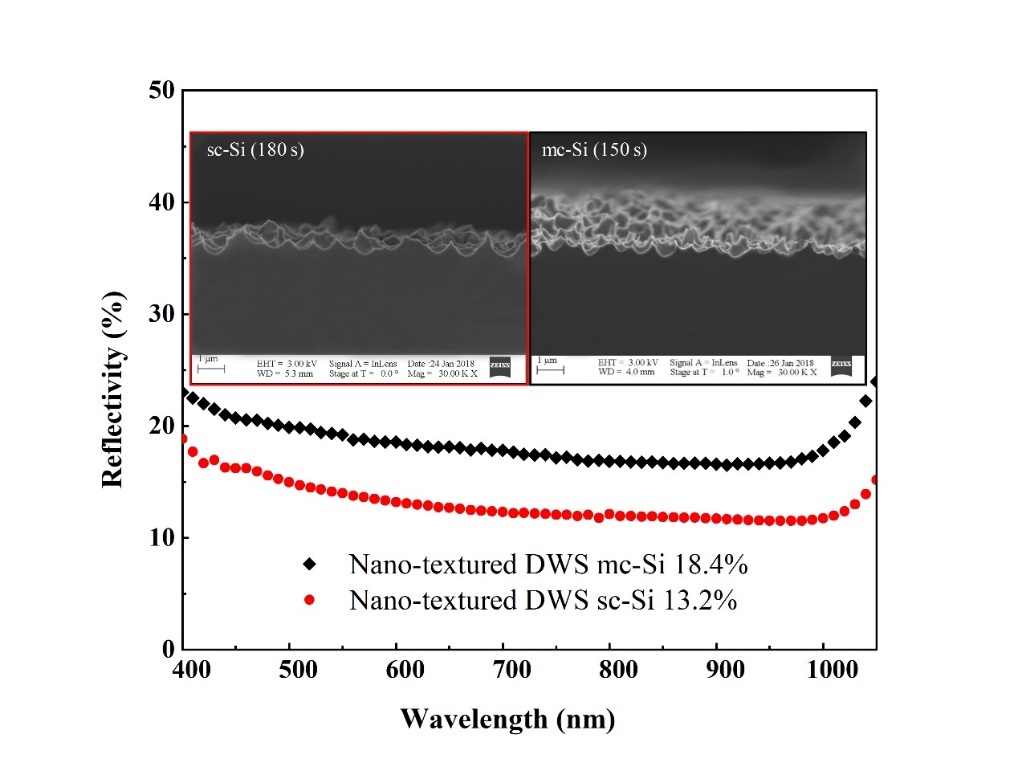J.M.Pearce (talk | contribs) m (→Source) |
J.M.Pearce (talk | contribs) m (→See also) |
||
| Line 22: | Line 22: | ||
==See also== | ==See also== | ||
* [[Influence of metal assisted chemical etching time period on mesoporous structure in as-cut upgraded metallurgical grade silicon for solar cell application]] | |||
* [[Economic Advantages of Dry-Etched Black Silicon in Passivated Emitter Rear Cell (PERC) Photovoltaic Manufacturing]] | * [[Economic Advantages of Dry-Etched Black Silicon in Passivated Emitter Rear Cell (PERC) Photovoltaic Manufacturing]] | ||
* [[Effects of silver catalyst concentration in metal assisted chemical etching of silicon]] | * [[Effects of silver catalyst concentration in metal assisted chemical etching of silicon]] | ||
Revision as of 14:46, 9 April 2019
Source
- Kexun Chen, Jiawei Zha, Fenqin Hu, Xiaoya Ye, Shuai Zou, Ville Vähänissi, Joshua M.Pearce, Hele Savin, Xiaodong Su, MACE nano-texture process applicable for both single- and multi-crystalline diamond-wire sawn Si solar cells.Solar Energy Materials and Solar Cells191, March 2019, pp. 1-8. https://doi.org/10.1016/j.solmat.2018.10.015 open access
Highlights
- Diamond-wire-sawing (DWS) holds promise for decreasing solar costs.
- Explores impact of nanotexturing on DWS sc-Si and mc-Si.
- Nano-texture using a metal-assisted chemical etch (MACE) technique.
- Step-by-step characterization of surface structure and reflectance after each MACE substep.
- Conversion efficiencies of 19.4%, 18.7%, for sc-Si and mc-Si solar cells, respectively.
Abstract

The photovoltaic (PV) industry requires efficient cutting of large single and multi-crystalline (sc- and mc-) silicon (Si) wafers. Historically multi-wire slurry sawing (MWSS) dominated, but the higher productivity of diamond-wire-sawing (DWS) holds promise for decreasing PV costs in the future. While surface texturing of DWS wafers is more complicated than of MWSS wafers, especially in mc-Si wafers, nanotexturing has been shown to overcome this challenge. While the benefit of nanotexturing is thus clearer in mc-Si, a universal nano-texture process that also works on sc-Si would simplify and reduce the investments costs of PV production-lines. In this paper, such a nano-texture process is developed using a metal-assisted chemical etch (MACE) technique. Step-by-step characterization of surface structure and reflectance of the MACE process is used after: 1) wafering, 2) standard acidic texturing etch, 3) silver nanoparticles deposition, and 4) MACE nanotexturing for both sc and mc-Si. The results show that the same MACE process works effectively for both sc-Si and mc-Si wafers. Finally, the nano-textured wafers are processed into PV cells in an industrial process line with conversion efficiencies of 19.4% and 18.7%, for sc-Si and mc-Si solar cells, respectively.
Keywords
Black silicon; Black Si solar cell; Metal-catalyzed chemical etching; Metal-assisted chemical etching; Micro-texture; Nano-texture; Photovoltaic
See also
- Influence of metal assisted chemical etching time period on mesoporous structure in as-cut upgraded metallurgical grade silicon for solar cell application
- Economic Advantages of Dry-Etched Black Silicon in Passivated Emitter Rear Cell (PERC) Photovoltaic Manufacturing
- Effects of silver catalyst concentration in metal assisted chemical etching of silicon
- Advances in plasmonic light trapping in thin-film solar photovoltaic devices
- Plasmonic Perfect Meta-Absobers for a-Si PV Devices
- Multi-resonant silver nano-disk patterned thin film hydrogenated amorphous silicon solar cells for Staebler-Wronski effect compensation
- A new method of preparing highly conductive ultra-thin indium tin oxide for plasmonic-enhanced thin film solar photovoltaic devices
- Ambiance-dependent Agglomeration and Surface-enhanced Raman Spectroscopy Response of Self-assembled Silver Nano-particles for Plasmonic Photovoltaic Devices





